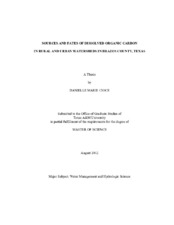| dc.contributor.advisor | Aitkenhead-Peterson, Jacqueline A. | |
| dc.creator | Cioce, Danielle | |
| dc.date.accessioned | 2012-10-19T15:30:31Z | |
| dc.date.accessioned | 2012-10-22T18:04:02Z | |
| dc.date.available | 2014-11-03T19:49:14Z | |
| dc.date.created | 2012-08 | |
| dc.date.issued | 2012-10-19 | |
| dc.date.submitted | August 2012 | |
| dc.identifier.uri | https://hdl.handle.net/1969.1/ETD-TAMU-2012-08-11638 | |
| dc.description.abstract | The Bryan/College Station (B/CS) region has been reported to have elevated concentrations of dissolved organic carbon (DOC) in surface water. Increased DOC concentrations are worrisome as DOC has been shown to be an energy source for the recovery and regrowth of E. coli and many watersheds are impaired by high bacteria levels. To examine the sources and fates of DOC in rural and urban regions to better understand DOC movement though the environment, seven watersheds were studied. To investigate source, streams were analyzed using diffuse reflectance near infrared spectroscopy (DR-NIR) and carbon isotopes. Fate of DOC was determined through monthly streams samples, gathered between March 2011 and February 2012, which were incubated for biodegradable DOC (BDOC). Soil in the region was sampled based on land use categories. Soil was analyzed for DOC and BDOC as well as DOC adsorption, the other major fate of DOC. Above ground vegetation was sampled in conjunction with soil and analyzed for BDOC.
Data indicated that fecal matter from cliff swallows provided considerable organic material to streams in the B/CS region as shown through DR-NIR. Carbon isotope values in streams ranged from -23.5 +/- 0.7% to -26.8 +/- 0.5%. Stream spectra may be able to predict carbon isotope values in streams (Adj. R2 = 0.88). Mean annual stream DOC concentrations ranged from 11 +/- 3 mg/L to 31 +/- 12 mg/L, which represents a significant decrease in DOC between 2007 and 2011. Concurrent increases in pH and conductivity were also recorded. The decrease in DOC and the increases in pH and conductivity may be due to impacts of high sodium irrigation tap water. Biodegradable DOC was low in streams, which is likely due to DOC being present in streams in refractory forms that are resistant to microbial breakdown. Soil chemistry, including soil adsorption, was greatly influenced by sodium. The elevated adsorption coefficients and release values seen in highly developed and urban open areas can be attributed to frequent exposure to high sodium irrigation water. The results indicate that sodium is a major driver of DOC in the system. Sound management decisions concerning irrigation water chemistry and urban development might eventually emerge to protect water quality as a result of this research. | en |
| dc.format.mimetype | application/pdf | |
| dc.language.iso | en_US | |
| dc.subject | dissolved organic carbon | en |
| dc.subject | biodegradable dissolved organic carbon | en |
| dc.subject | soil adsorption | en |
| dc.subject | near infrared spectroscopy | en |
| dc.subject | isotopes | en |
| dc.title | Sources and Fates of Dissolved Organic Carbon in Rural and Urban Watersheds in Brazos County, Texas | en |
| dc.type | Thesis | en |
| thesis.degree.department | Soil and Crop Sciences | en |
| thesis.degree.discipline | Water Management and Hydrological Science | en |
| thesis.degree.grantor | Texas A&M University | en |
| thesis.degree.name | Master of Science | en |
| thesis.degree.level | Masters | en |
| dc.contributor.committeeMember | Boutton, Thomas W. | |
| dc.contributor.committeeMember | Wilcox, Bradford P. | |
| dc.type.genre | thesis | en |
| dc.type.material | text | en |
| local.embargo.terms | 2014-10-22 | |


